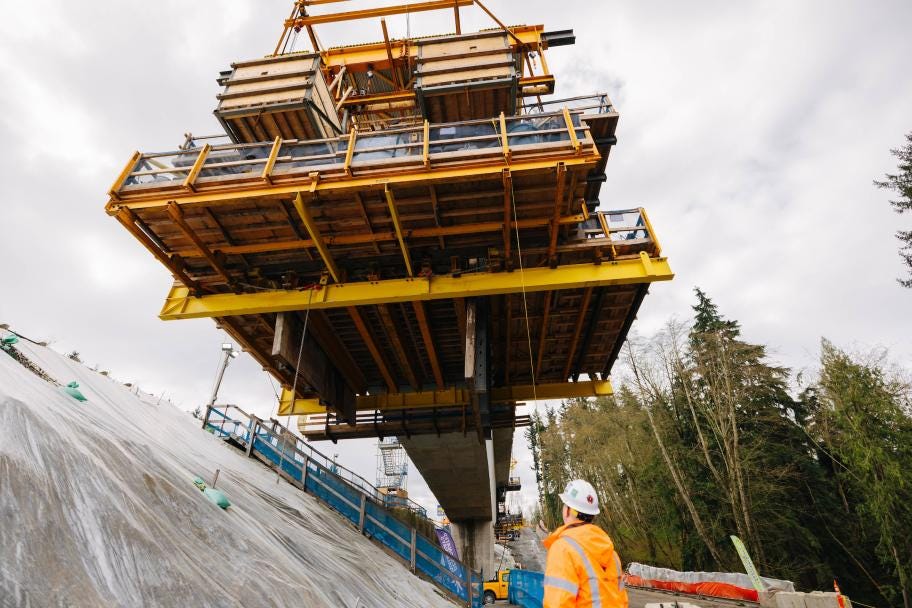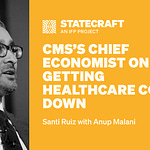Last week, we talked to Stephanie Pollack about salvaging a transit project in danger of failure — it was the first in a set of interviews we’re running on transit. Today, we’re zooming out further, and looking at how the federal government funds local transit.
I’m excited about the guest we landed. Peter Rogoff spent 22 years as a staffer on the most powerful Senate committee, the Appropriations Committee (on the Democratic side). “Approps” determines discretionary spending for agencies, and for most of his time there, Rogoff was the most senior Dem staffer.
Rogoff worked on three transportation reauthorization bills (in ‘95, ‘98, and ‘05), the bills that determine how money will be distributed to transit agencies across the country. In 2008, Rogoff was a key player in introducing the idea of making new funding available to “multi-modal” transportation projects — projects that benefit multiple types of transportation. The next transportation reauthorization process is coming up in 2026, and I thought it’d be valuable to better understand how that bill comes together.
But Rogoff doesn’t just have experience budgeting: the following year, Rogoff was appointed as head of the Federal Transit Administration (FTA), where he served for five years. More recently, he’s been the CEO of Sound Transit, the Seattle transit agency.
I didn’t agree with Peter on everything in this conversation (which was recorded in February), and he’s taken his fair share of criticism, but it’s hard to find a figure in American life who has spent more time thinking about federal transit policy.
We discussed:
What does the FTA do?
Why don’t transit agencies control their spending?
How do you win Senate funding fights?
Why are streetcars terrible?
Thanks to Rita Sokolova for her judicious edits.
What does the Federal Transit Administration do?
Within the US Department of Transportation, there are a number of “modal” administrations, as in modes of transportation. Some of the better-known ones are the Federal Highway Administration and the Federal Aviation Administration. The Federal Transit Administration (FTA) is another one: it’s both the federal funder and grantmaker of transit agencies all across the country. It also regulates those transit agencies to comply with federal rules.
When I think of transit, I don't just think of buses, light rail, and subways, but that's what it means in this context, right?
Right. It is principally about buses, bus rapid transit (BRT), vans, medical transportation, and the major public rail systems, ranging from the New York City subway system all the way down to small streetcars in several cities across the country.
There is also a Federal Railroad Administration, which oversees freight rail and intercity rail, like the Amtrak system. There's actually a lot of overlap between what the FTA and the FRA do — they’re two different grantees that sometimes share the same track.
The FTA has a budget for grants to cities and states. Can you give me a pie chart of that budget?
Well, the majority of those funds are annually allocated by formula to each of the transit agencies, and those dollars are very important. It’s kind of ironic, but when you testify before Congress, you sometimes get the sense that Republican members of the House just view transit as an urban activity that they needn't care about in red America, when in fact the transit agencies in more rural and suburban areas are more dependent on federal dollars than the large urban systems are. The reality is, they're all dependent on federal dollars, but the larger systems get a smaller portion of their total budget from the federal government, while the smaller systems may get 80-90% of their costs totally covered.
Roughly what percentage of costs does the federal government cover for a major urban transit agency like in New York or DC?
This is something I suspect we're going to come back to a lot in this interview, and it's an expression I used frequently while at the FTA: if you've seen one transit agency, you've seen one transit agency. No two are really governed or funded the same way, nor have the same passenger profile or ways and means of moving people.
Population, ridership, and the age of the system are factors. It’s not a dominant factor, but older systems have more and older infrastructure to maintain. There is one program in which systems that are older than a certain date are eligible for the first tranche, then slightly newer systems can participate in the second tranche, and third systems are in another tranche. But it's principally about ridership, and there are tiers based on how many riders you carry per year.
It's funny that you mentioned DC, because the Washington metro system gets a separate $150 million to transport federal employees. I would have to pull up data from the National Transit Database (NTD) to give you the percentages, but this is my point — there isn't a rule of thumb. Some get state appropriations, and some don't and are wholly dependent on what the city puts up. Some get sales taxes, but not property taxes. Some get property taxes, sales taxes, and motor vehicle excise taxes.
The federal formula stipulates how much they're going to receive based on a set of criteria, but it's never everything they need, so they need to piece together their own local system and resources to decide how large and robust of a system they want. When you look across the 900 transit agencies in America, it's everything from a five-van operation to the entire Long Island Railroad.
Who's running that five-van operation?
There are small transit agencies on Native American territories that connect workers to their places of employment. There is also a partnership between transit agencies and Medicaid that grants Medicaid recipients a transportation allocation to get to and from medical appointments, and small transit agencies provide that access. There are probably some agencies with fewer than five vans.
How does the federal funding formula work?
It depends on a variety of factors. As I saw over multiple decades, there's a formula that's in the law, and then there's superseding legislation that takes dynamism into account. For example, if an agency is suddenly going to lose money due to the census and population loss, then legislation prevents those losses. Many federal programs also have small state minimums, so a state like Rhode Island or Alaska gets way more per mile of highway or per number of passengers than states like New York and California do. Focusing on the formula in the law isn't always that helpful.
I will always remember a trip I took through Cleveland when I was the FTA administrator. I had been touring the country giving a speech touting the fact that the Obama administration budget was going to bring increased federal funds to their local transit agency. When I got to Cleveland, I looked through the talking points that the staff prepared for me and didn't find that bit, the winning talking point in the speech. I called back to the office and was informed that Ohio’s allocation was going to decline, because we were implementing the new census and Cleveland was losing population. So, you know, you pivot.
What did you pivot to?
I spoke about the need for them to adequately maintain their existing system. One of the signature issues of my tenure was the State of Good Repair. When I was first confirmed as administrator, I gave a speech that was somewhat controversial. It was at the Federal Reserve Bank in Boston — at the time, Boston’s MBTA was really struggling with deteriorating service because of the age of their system. At the same time, they and many other cities had applied for federal funds to expand their systems. In this speech, I focused on whether it was really appropriate for us to send more taxpayer dollars to transit agencies when they weren't adequately maintaining the system that we'd already built for them.
Some folks found it a little blasphemous of me to say that they were going to be held accountable for how well they were maintaining their systems. I ultimately focused on that a lot in my tenure there and, thankfully, as a result of that drumbeat, Congress actually authorized a whole new category of grants specifically for the maintenance of major systems.
When I was preparing for this interview, I came across a lot of pushback to that speech. You had said,
“Supporters of public transit must be willing to share some simple truths that folks don’t want to hear. One is this — paint is cheap, rails systems are extremely expensive. Yes, transit riders often want to go by rail. But it turns out you can entice even diehard rail riders onto a bus, if you call it a ‘special’ bus and just paint it a different color than the rest of the fleet. Once you’ve got special buses, it turns out that busways are cheap.”
What was the feedback you got to that line of argument?
The dominant mindset is that trains are inherently better than buses, but the reality is that the majority of transit trips in America are taken by bus. At that time, there was an increasing use of bus rapid transit, which is sometimes referred to as “trains on wheels.” There really are some very good ones that mimic train operations; they have their own busways, which are designated lanes with no encroachment from automotive traffic. There are also some really dumbed-down systems that call themselves BRT, but are really just express bus service in mixed-use traffic. I said that paint is cheap because the bus-only lanes are often painted red. One of our projects was a dedicated busway from Hartford to New Britain, but I also signed a historic number of grant agreements for rail expansion. I just thought it was important that we ask this question.
When the folks from Muni in San Francisco came in for expansion money, I required them to go back and do a review of what it was really going to cost them to adequately maintain their system. The problem wasn't just a lack of funding for maintenance; they were not being very sophisticated or smart about how they were maintaining the system.
Some transit agencies would replace certain components every three years even though they could last seven, and other components were replaced every seven years, but broke down every three. Getting more sophisticated and precise about the total cost of ownership seems like a no-brainer today, but transit agencies were slow to get there.
Some of these transit agencies are very big and well-staffed, and they've got lots of resources. Why do they need an FTA administrator to push them on that stuff? Why aren't they self-correcting?
The ones with really good leadership are, but I’m talking about a time well before the Six Sigma Revolution, when people started looking at the entirety of their operations and launched into continuous improvement. There's a mindset in certain transit agencies of, “We've always done it this way. Why would we change?”
I recently did a major assessment of the railcar procurement processes of a large and long-standing rail transit agency in America, and there were a lot of eye-opening conclusions. They’ve been purchasing railcars using practices that are serving them very poorly in the current day, especially in a changed marketplace. They weren't really ready to change, and there’s still internal resistance to some of our recommendations. There’s a lot of inertia in old-line public agencies.
Do transit agencies have a natural default to expand rather than to do more maintenance?
There's far more political momentum behind expansion than maintenance. Transit boards are often populated by local elected officials — when I ran Sound Transit in Seattle, I had a governing board of 18 local elected officials, which was particularly large. Each of those elected officials represented jurisdictions that wanted new rail service yesterday. In many cases, they put their political capital on the line to get voters to adopt tax increases to provide those rail systems and expansions.
Expanded rail service and new rail stations come with groundbreakings and ribbon-cuttings. It's harder to get elected officials to celebrate the replacement of a subsystem. It’s just like water and sewer — it's a service that people take for granted and often don’t see, until the inadequate maintenance translates into deteriorated and unreliable service, which then sours people on using transit. Part of the reason people really need to stay on top of maintenance is because they'll lose ridership if they're not reliable.
Was it part of your role as FTA administrator to make that argument to local transit agencies?
I think transit agencies knew it, but we needed to say it out loud and get people thinking about it, like I did with Muni. We did eventually allocate a large chunk of federal dollars to expand their system, but we got them to be a lot more strategic in the process. They didn't want to come in and meet with me about their next expansion grant without talking about what they were doing on the State of Good Repair. That was an ethic that I tried to generate with transit agencies all over the country.
One of my colleagues on the IFP infrastructure team was very excited to ask you about the Transportation Investment Generating Economic Recovery (TIGER) Grants, which you helped negotiate and write the language for in your time as a professional staff member in the Senate. Those grants deviated from that classic formula system.
Could you explain how the TIGER Grants came to be?
TIGER Grants are one of a number of programs where non-highway projects can command large chunks of surface transportation money from the federal government, which is ironic because the idea for developing the TIGER program stemmed from a meeting I had with two highway commissioners. This was when the Obama administration was just coming into office and the economy was in its biggest recession since the Depression. I met with Kirk Steudle, who was the Highway Commissioner for the State of Michigan at the time, and Butch Brown, who was one of the Highway Commissioners in Mississippi. They explained to me that they had projects that were ready to be built — all of the environmental work had been done and they had qualified bids — but they were canceling the procurement because of the loss of revenues due to the recession.
In the Recovery Act, we were charged with coming up with ways to get people back to work. I went to Senator Murray, who was the chair of the Transportation, Housing and Urban Development Subcommittee at the time, and suggested that rather than going by the usual formulas, we should allocate a big chunk of transportation dollars to getting some of game-changing projects off the cutting room floor. We had a good bit of resistance; some of the entrenched folks on the Environment and Public Works Committee thought that everything should have gone out by highway formulas. Eventually, they didn't carry the day.
Can you explain that rivalrous relationship between committees for our readers?
The jurisdiction between some committees gets murky. The House Appropriations Committee was charged with putting together the Recovery Act, principally through a series of appropriations on two already-established programs. Those programs are authorized by other committees. In the Senate, the Environment and Public Works Committee authorizes highway programs, the Banking Committee handles transit programs, and the Commerce Committee handles rail programs, meaning intercity rail and Amtrak-type programs. The House also had balkanized committee jurisdictions for different transit modes, but they actually reformed that many years ago.
So on the House side, all transit gets authorized by the same committee?
Yes. Highways, transit, and rail are all authorized by what's now called the Transportation and Infrastructure Committee. In the Senate, it's divided across those three committees, which sometimes results in jockeying. In this case, the Senate Appropriations Committee was charged with developing the transportation portion of the Recovery Act, and we did, for the most part, put appropriations into known programs to get dollars out the door. But the TIGER program was an innovation. It didn't follow the norms and that got some people disgruntled.
Can you explain what that innovation was?
It was going to be a large discretionary grant program, rather than formula grants that would be peanut-buttered across the country. We worried that if we just followed the formula, everyone would get a little bit of money, but that it wouldn't be enough to get these big projects off the cutting room floor. If you had a discretionary grant program where the Secretary could select projects that were notable and important, especially to a national transportation system, then bigger grants could go out. We initially got a fair degree of resistance from the then-senior Democrat on the Environment and Public Works Committee, Barbara Boxer of California. I used to kid her about that because she eventually lobbied for and celebrated TIGER Grants, as she should have.
The program evolved. There will always be jurisdictional tussles between committees, but what started as a conversation about highway projects actually morphed into getting some major investments into intermodal projects. For the first few years of the TIGER program, it was a good opportunity to fund things like the streetcar projects that many mayors wanted. The FTA administered those grants, but they were allocated by the Secretary's office with my input. Bike and pedestrian projects, which cities and counties never got around to doing, also qualified, and we could give them fairly small grants.
Another big departure that ruffled some feathers was that we didn’t follow the so-called 80-20 highway-transit split — there's a long-standing dogma in transportation policy land that 80% of funding should go to highways and 20% to transit. It originated in the fact that 20% of the Highway Trust Fund’s revenues was deposited in the mass-transit account of the Highway Trust Fund, and 80% was put into the highway account. The Highway Trust Fund has long been underwater; last I checked, it had to raise at least $170 billion over the last three or four reauthorizations just to stay afloat. So its revenues are barely relevant, because the program is surviving on general fund bailouts every few years.
What’s the multimodal piece of the TIGER program?
TIGER was innovative in that it can go to almost any mode — it can even go to port projects. It could also go to some freight rail improvements, which was controversial at the time, because freight rail infrastructure is privately owned by Class I or shortline railroads. When I started in transportation in 1989, putting public dollars into privately owned infrastructure was a big red line, but that was something that we pierced through. It was especially needed for port projects, because they really didn't have a good place to go [for funding]. There was a big problem with the competitiveness of our ports internationally — we were bleeding a lot of traffic to Prince Rupert in Vancouver in British Columbia, and to Halifax on the East Coast.
So TIGER grants could go to any transportation mode, and they were merit-based. Can you tell me more about how you factored in the national transportation system and where these dollars could be best allocated to keep big projects alive?
Like I said, it morphed over time. If you look at the first round of TIGER, there were some very large allocations — over $1.5 billion. In subsequent years, the program survived, but at something like a third of funding, which was where it stayed. Then, as a result of the infrastructure bill, it got far larger again. I think the name of the program has now changed twice, and the authorizing committees finally went in and actually authorized the program’s rules.
Back when we were dealing with the Recovery Act, it was wide open and the Secretary's office was charged with developing the evaluation criteria. During my time, there was no notion of a set amount that would go to highway projects vs. transit projects vs. freight rail projects vs. port projects. It really was merit-based, and a matter of which projects were justified. Congressional inputs mattered too; we wanted to know which projects were important to the congressional delegations that were putting up this money every year.
An innovation that we developed under the Obama administration was what we called TIGER Challenge Grants. Not all projects were shovel-ready, which President Obama was looking for in the Recovery Act, but they needed additional money to get through planning and design. It wasn’t written into the law, but we provided challenge grants where we would say, “Here's a smaller amount to keep you moving forward, please come back when you're ready and apply for a full-fledged TIGER Grant.” I think a number of the projects that got those challenge grants did eventually get the full grant.
How do you compare the merits of a good bike path program to those of something like highway expansion?
It's not easy. I don’t remember all of the factors we looked at, but we did score them. It wasn't a hard numerical score, because that would just give rise to false precision. We didn’t say, “Oh, this project gets an 84 for sustainability, but the other one gets a 76,” but we did rack and stack them. We then organized the projects into groups of highly recommended projects, recommended projects, and not recommended projects. And it’s not that the “not recommended” projects weren't good projects: they just weren’t fully baked.
There was one area where I think we had an excessive amount of confidence. Mayors across a number of cities wanted to bring streetcars back to their downtown landscape, but streetcars are not a very good mode of transportation. They are an economic development project.
What do you mean by that?
Wherever you build a streetcar, there will be a considerable improvement to housing and retail. That area becomes a destination for dining out and entertainment. Streetcars are not a very quick way to get people from one end of the city to the other, but a number of mayors were interested. Secretary LaHood wanted to help them, so we funded quite a number of them in Cincinnati, Dallas, Seattle, and New Orleans, which had already had streetcars for a while.
In many cases, the applicant for the grant was the city’s transportation department, which, in retrospect, was a mistake. Many of those projects ultimately had to be taken over by local transit agencies, because they were the ones with experience in rail construction and planning. A lot of city departments thought they were just going to lay some tracks on top of the existing street and run a train up and down them. They didn't really think about the power supply system that would move the train.
I remember having a very difficult conversation with the then-Mayor of Cincinnati about the fact that he had already let a contract to build his streetcar. That contract didn’t have any federal assurances, so we couldn't send him a check, because it was non-compliant.
What would have prevented the Department of Transportation from making that mistake?
It would have been easily handled if we’d funneled the money directly through the Federal Transit Administration, rather than having the Secretary's office make grants, presuming that the grantee was sophisticated enough to access the dollars, and then having the FTA eventually administer the grants after the awards were made. In retrospect, we should have done that.
But you have to remember, in those first two years with the Recovery Act, it was about getting grants out the door to get people back to work. That was the imperative, which was made clear by a great tool that I have subsequently used in other parts of my career. Secretary LaHood had a meeting of all of the modal administrators on Thursday mornings, where we reported our progress on getting Recovery Act dollars out the door. Lana Hurdle put together the PowerPoint slides on each agency's progress. So on Wednesday nights, we were all desperate to get her our most up-to-date data. A ton of work got done on Tuesdays and Wednesdays, because everyone knew Thursday was coming. It was a very effective tool to keep people working, and I used it as agency head in Seattle.
Tell me more about your time as a member of the Senate Appropriations Committee staff. You played a key role in writing the TIGER Grant legislation, and one source notes that you helped “build support for this approach within the Senate.”
Like in any role that advocates for legislation, you have to build a coalition and show folks that they might have an interest in it. For example, with the TIGER program, we appealed to senators who had maritime interests, because there weren’t any other grant programs for ports. We would get on the phone and remind folks that, “Yeah, you're going to get a letter from Senator Boxer that says that this is an ‘inappropriate’ way to distribute the money, but this is an avenue for you to finally get the money that you've been looking for for years.”
We did not follow the 80-20 split, and I reminded folks who had an interest in rail and transit projects that this was an important departure that should stay on the books. Kirk Steudle from Michigan and Bush Brown from Mississippi went back to their senators and reminded them that this idea originated with their own highway commissioners. I worked for the Democrats, but it didn't matter. We all worked much more collaboratively back then. It's just a matter of working the process.
I had the privilege of working for the Appropriations Committee, and the appropriations bills had to pass every year to keep the government running, so I didn't have the burden of convincing people that this bill should have a hearing and actually get to the floor. Most staff have a hard time even getting a bill into consideration. I was there for 22 years, and in my early years I just scratched my head about these folks who spent their entire life on one piece of legislation that never got anywhere. The appropriations bills had to pass, which meant that things that didn't always belong there ended up on them.
But we had a lot of resources. Because the Appropriations Committee sets funding for every program in the discretionary budget, including the staffing levels in all the departments, when we called, people picked up the phone and helped us. They gave us data on fast turnarounds.
One thing I worked on with Senator Lautenberg when he was subcommittee chairman was lowering the drunk driving threshold for blood alcohol content to 0.08% nationally. That was done as an amendment to the Transportation Appropriations Bill.
Even though there was no appropriation of money involved, per se?
Well, in the early years, the mechanism was to sanction states that didn't do it, as they had when setting the minimum drinking age. So we had a hook. More importantly, we had a ranking member, Senator Lautenberg, who was instrumental in changing the minimum drinking age. He was adamant about lowering the blood alcohol content limit to something more reasonable. The House Transportation Subcommittee Chairman, Republican Frank Wolf, also supported it. Lautenberg and Wolf had a number of meetings, and we got to the conference between the House and Senate.
We were fought vociferously by the senior Democrat on the Appropriations Committee in the House, Dave Obey — he represented Wisconsin, where people brew a lot of beer. They did not want the blood alcohol content limit lowered. So we had the “saloon lobby” and the beer brewers vs. Mothers Against Drunk Driving. We ultimately carried the day and it became law. The prohibition on smoking on airlines was also done as an amendment to the Transportation Appropriations Bill [In 1988].
You were a staffer on the Appropriations Committee through the negotiations and eventual passing of the 2009 stimulus bill. After that, you were appointed to the FTA. You went from helping negotiate the FTA's funding to helping run it. What was your plan of action going in?
Well, Secretary LaHood's plan of action mattered more than any idea that I had in my head, and his idea came down from President Obama. We had to put dollars to work quickly, so we obligated grants at an unprecedented rate. Those were critically important to a number of transit agencies that were watching their revenues dry up very quickly. Some of those agencies’ direct revenues relied on a portion of a sales or property tax, and a great many of them are dependent on annual appropriations from their city or county council or from the legislature. Those entities were also seeing their revenues dry up, and not just for transit, but for everything else — for law enforcement, firefighting, and basic services. So they were making really hard choices.
I'd like to think that the Recovery Act made their transit choices easier because we were getting more money in the hands of the transit agencies quickly. This wasn’t like COVID where ridership dropped off drastically. Ridership dropped off a little bit because of lower employment, but they still needed to provide the service. One of the worst things that can happen in public transit is that you decrease the frequency of the service so much that it becomes unreliable and people turn to other options.
Over the last four years, there's been much public debate about the speed of getting money out the door, especially Biden’s infrastructure dollars, so topics like environmental review, grant processing, and state agency planning have come into focus. In your role, you had to try to move money through bureaucracies quicker.
What lessons did you take from that experience that you would have applied over the last four years?
I observed this debate from multiple angles. From the perspective of the Federal Transit Administration, 15 years ago, I was very frustrated with how the environmental process slowed the deployment of projects that were inherently environmentally beneficial.
It's still true today. Unfortunately, it has become a process that lends itself to litigation, and the litigants are not necessarily environmentalists. There are people who just want to extract something from the project or the project's budget, and they feel like the best way to do it is to attack the environmental process.
When I was in the Obama administration as undersecretary, we actually put forward a full-blown reauthorization bill, and we did it the old-school way, where the administration submits an entire bill formally to Congress. It took many months to get it off the ground, but we also surprised a lot of people by transmitting an entire bill and not just letting Congress have the only say on it. In the very first title of that bill, we had an environmental streamlining provision. Some people were surprised that the Obama administration was supporting environmental streamlining, and not every one of those provisions was adopted by Congress. Some of them encountered opposition.
I think there's a broad bipartisan understanding that the process is far from ideal. The challenge is getting some kind of bipartisan consensus on how to fix it without unraveling important protections.
Did you have any tools at your disposal as FTA administrator to speed that process along?
It’s a matter of whether you're leaning in or leaning back. A lot of people forget that although the environmental impact statements are actually largely handled and produced at the grantee's cost, it’s actually a federal document that's signed by the federal agency. So like every other legal issue, you need to be advised by the lawyers on what risk you are taking by leaning in and saying, “This environmental document is adequate.” Environmental concerns are very different across the FTA’s 10 regions. The concerns in a document coming out in the Pacific Northwest will differ significantly from those in one for Region 4.
What is Region 4?
Region 4 is based out of Atlanta and handles the southeastern United States. There are unique local conditions that we need to pay attention to, and we need to understand whether things can move more quickly in certain places. In recent years, the FTA has tried to get more consistency in the quality and diligence of these documents. The thing that always struck us is how much more detailed transit environmental documents needed to be, compared to those for highway projects. The Federal Highway Administration has a very different set of strictures and comfort levels than the Federal Transit Administration does.
Where does that come from?
I think it stems from the fact that when the Interstate Highway System started under Eisenhower, they could just say, “This is what we're going to build,” and then just do it. The Bureau of Roads would just plow ahead and start building the interstate because that was the directive, and NEPA didn't come for many years. But state DOTs and highway departments have more cards in their hands when going through this process than a transit agency does.
Like what?
They can condemn property without going through such a protracted process. This is certainly not an insult to Washington State’s current transportation secretary, but when Sound Transit proposed to build light rail through the Puyallup Reservation in Pierce County in Washington state, I met with the tribal leaders, and to their great comfort, I explained that we would handle it better than the Washington Department of Transportation had when they ran a highway through their property years ago.
The longer I’ve been in the industry, the more I’ve come to appreciate the fact that the highway and aviation programs are born out of the Constitution’s commerce clause, whereas the transit program, which is largely localized, is born out of the public welfare clause. The case law that has evolved has resulted in the differences we see today.
When NEPA geeks talk about consensus, the consensus is that consensus is overrated, that it’s another word for everybody getting their pound of flesh. What do you make of that?
One of the things that I learned when I moved from being a policymaker and federal funder to actually running an agency that needed to get permits to build transit expansions through cities is that if you're in an environment where your elected officials just want to make everybody happy, you're really at a disadvantage, because there are hard choices that need to be made.
We have a real challenge in Washington State: we don't have a state income tax. As a result, municipalities can only raise property taxes (the growth of which is capped at the state level) and sales taxes. And then you pay fees for everything else that isn't nailed down. That results in cities and counties being underfunded. If you try to build a light rail system with a multi-billion-dollar budget through a city the size of Mountlake Terrace, that city council is going to have visions of all of the other things that can get fixed along the way. Sound Transit’s legal obligation is to return the property to the condition it was in when we arrived to build the light rail system.
Whenever you want to build through a city, that city will have visions of what it wants to do with its local streets and sidewalks, and they’ll think that that should happen on the transit agency’s dime. Not all of that is bad — when you want to introduce a station to a new community, you want that to be a vibrant station that has good access and that you build some affordable housing near. We have a whole program to try to make that happen, both at the federal level and at Sound Transit.
But some of these interfaces with local cities, especially when you need to get a local permit to build through them, can start resembling extortion. I know that's a harsh word to use, but I said “start resembling.” They know what they want, and they will sit across the table and stare at you until they can get it. Sometimes you need to go to the mat and fight them and tell them they're not going to get it — we did that before I arrived at Sound Transit with the city of Tukwila. I was in litigation with the city of Mercer Island for almost my entire time at Sound Transit. We ultimately won, and Mercer Island taxpayers paid a ridiculous amount of legal fees just to lose.
What was the fight over, in that particular case?
Mercer Island is a very prosperous suburb of Seattle. They've always thought that they deserve more than everybody else. Somehow, single occupancy vehicles from Mercer Island were allowed to use the HOV lane to go into Seattle, even though there was nothing in the law that allowed it. When we rebuilt the HOV lanes in order to provide light rail down the middle of the I-90 bridge, we had to take away that option. People complained that they were promised that they'd be able to use the HOV lane when they bought their houses. It's like, I'm sorry that some realtor promised you that, but it doesn't exist anywhere. They also wanted dollars to reconfigure their street grid, even though our modeling showed that there would be no traffic impact. They found some modeler to say they needed tens of millions of dollars for that project. Their asks were so outrageous that it was inevitable that we would end up in court.
If the FTA grants money to a local transit agency for a project, and that project is delayed and over budget, what can the FTA do to help curtail project bloat?
There was a time when I would have focused my answer to that question on whether the FTA is adequately monitoring the technical sophistication of the agency, and that if you're to make a major capital investment, you need to find them technically capable of managing the project.
But the reality is that we really are in a period of hyperinflation, and the fact that project costs are growing so rapidly across the country is not an indication of incompetence on anyone's part. That's not to say there isn't incompetence out there, but that's not the driving factor here.
Part of what I've been doing as a consultant is getting governing boards to understand that, as upsetting as their local project cost growth is, it's happening in Chicago and New York and Miami too. What the FTA can do is avoid giving grants to entities that aren't prepared to really build the project, as I mentioned in the streetcar example. But there’s no magic bullet that will make a project complete on time and on budget. You can't minimize some of these local impacts.
For example, in one of the Sound Transit projects that were under development, we found that the alignment may abut a Native American burial ground that is adjacent to one of the boarding schools that Native American children who were ripped from their families were sent to. We are not going to disrupt that ground, so a redesign may be necessary. These are the kinds of things that happen when you're on the ground.
Another example was in Tacoma — we extended streetcar-like light rail that was very short and not very useful into something much more useful that could reach a nearby community. When we ripped up the streets, the utilities were nowhere near where they were mapped to be. That resulted in a delay and redesign of the project. I actually now work as an advisor to a company that uses sensing technology to avoid that, and I'm involved with them precisely because of how badly that project burned me. To put it politely, stuff happens when you're in major construction.
Why are American transit costs exceptionally high on a dollars-per-mile basis when compared to those of our international peers?
Some of those comparisons are not apples to apples, but I think the delta is large enough that it's certainly relevant. Part of the problem is the very lengthy process that transit projects here need to go through, in terms of consulting and making everybody happy along the way through the environmental process. I'm currently dealing with a transit agency that is short on money to finish a project, but none of the board members want anything less than an iconic station in their community.
These are local elected officials who are looking out for their community, and there's nothing wrong with that. But I think a lot of the comparable European transit agencies and projects are run by national entities that have a lot more power to just move through the process and get things done quickly, which folks sometimes lose sight of. Some of those national authorities that are building transit agencies in other countries have some of their costs paid for by other national entities — that national agency that’s building electrified rail in Europe can just go to the national agency that provides power and say, “You need to wire up all of our traction power needs and new substations and provide the power sometimes for free.” We don't have that luxury here. Some of our projects are overdesigned due to NEPA requirements.
What advice would you have for the next FTA administrator on getting money out the door faster and streamlining grant making processes?
First and most importantly, as I said before, is to recognize that if you've seen one transit agency, you've seen one transit agency. You really need to know how they're governed and funded to figure out how to help them solve their problems. You need to scrape under the hype and figure out what their cash flows are and how and to what extent the federal government can help.
Getting the dollars out the door quickly is not always the best thing for a program that's just half-baked, because you need time to deliver the goods. A huge problem that I'm working on in another sphere is due to all of the interest in expanding the fleet of zero-emission buses, which everyone wants, especially the elected officials in states that are very focused on the Clean Air Act. In fact, California has a mandate to transition entirely to zero-emission buses by 2040.
Meanwhile, Austin’s transit agency has to leave 46 buses parked because one of the biggest suppliers of electric buses in the US found a way to go bankrupt, even with a historic level of purchase orders. Transit agencies are receiving the buses, but the local utilities have been so slow to actually wire up the power needed for the charging stations that the agencies are parking their buses, which is actually a very bad way to treat a bus from a maintenance perspective.
Getting things out fast isn't always the solution. I would love a new FTA administrator to work on this charging infrastructure issue with the Department of Energy. Sometimes it's not just a matter of what you have authority over, but which allies you could bring to the table.
The other thing you learn when trying to advance policy changes is that timing is everything. When we first took over from the Bush administration, there were accusations — not all of them wrong — that the criteria used to decide which major rail expansions qualify for funding often worked to the disadvantage of minority communities. In fact, then-Congressman Keith Ellison, who is now the attorney general of Minnesota, introduced a bill that called our process racist. There were clearly problems with that program, which were exhibited in a project to connect Minneapolis and St. Paul with light rail. They were literally going to build the foundations for three stations, but not build the stations themselves, because they were in the heart of the black and Hispanic communities between Ramsey and Hennepin County. The added cost of those three stations that might serve some of the most transit-dependent population was going to put the cost of the project above the Bush administration's criteria.
OMB was very enamored with this criteria, and they thought it was a good merit-based way to distribute money, so Secretary LaHood and I had to appeal to them to reverse it. The week of our meeting with OMB Director Peter Orszag, it emerged that he was about to have a child by a woman other than his fiancee. He was focused on keeping his job that week, so when we went to discuss this policy change, he was amenable and agreeable, and it was very important to him that we told all the members of Congress that he helped make this happen. Timing really is everything.
One last thing I’ll mention is that when you're a member of a political team, you're often charged with fixing a problem that may not fit neatly into your job description. When I was the FTA administrator, I still had ties with Senator Daniel Inouye's office because he was the senior appropriator on the Appropriations Committee. I had a good deal of experience with the Essential Air Service program that subsidizes airlines to serve remote areas that otherwise wouldn't be served. The island of Molokai, where the leper colony had been, lost its air service. I somehow ended up being charged with fixing the problem.
Now, I was the FTA administrator, and it was nowhere near my job description, but a fix was needed and you use the talent you have. And, frankly, I was flattered that he asked me to help fix it. A good lesson for any leader is to look at all of the talents that everyone brings to the table. If people look past their territoriality, you can get better results.













